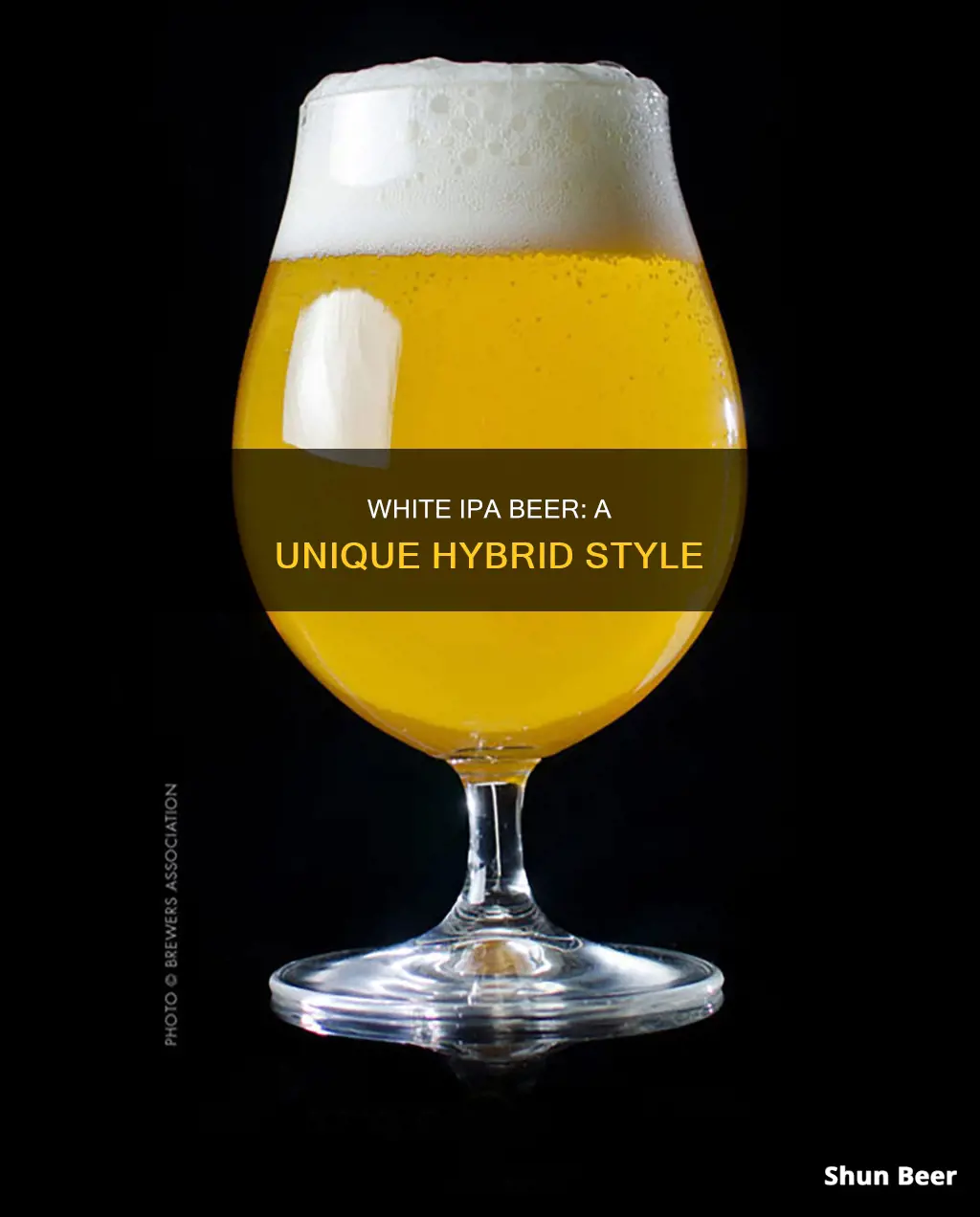
White IPA is a style of beer that combines the flavour profile of an American IPA with that of a Belgian Witbier. It was created in 2010 by two brewmasters, Larry Sidor of Deschutes Brewery in Oregon, and Steven Pauwels of Boulevard Brewing. The result is a crisp, hazy, moderately hoppy, and lightly spiced IPA with a wide colour range, from light yellow to deep gold. The Beer Judge Certification Program officially recognised White IPA as a new style in 2015.
| Characteristics | Values |
|---|---|
| Colour | Ranges from hazy deep gold to hazy pale yellow |
| Head | Moderately large white head that sticks around |
| Aromas | Light-to-medium spice; Fruity esters; Low-to-moderate hoppiness |
| Flavours | Moderate-to-high fruity esters; Light & bready maltiness; Notes of grapefruit, orange, apricot or banana; Clove & other spices; High hop bitterness; Medium-to-high hop flavours |
| Body | Medium-light |
| Carbonation | Medium to medium-high |
| ABV Range | 5.5–7% |
| IBU Range | 40–70 |
| Serving Temperature | 8–10º C (46–50 ºF) |
What You'll Learn

History of White IPA
The White IPA is a hybrid of two distinct beer styles: the American IPA, known for its high hop character, and the wheat-based Belgian Wit, known for its refreshing and spicy flavour. The style was born out of a collaboration between two craft brewers: Larry Sidor, the brewmaster at Oregon-based Deschutes Brewery, and Belgian-born Steven Pauwels, brewmaster at Boulevard Brewing. In 2010, they developed a collaboration recipe that combined the strengths of their respective breweries.
Deschutes Brewery was known for its hoppy brews, while Boulevard Brewing was known for its expertise in wheat beers. Their experimental recipe included additions of lemongrass, white sage, coriander, and orange peel. After agreeing on the recipe, each brewer went their own way and produced their own version of the beer. Deschutes called theirs Conflux Series No. 2, while Boulevard's version was named Collaboration No. 2 under their Smoke House Series.
The two beers, despite being born from the same recipe, turned out quite differently. The collaboration created a buzz in the beer world, especially among craft beer drinkers who went out of their way to hunt down one or both of these new brews. The success of this collaboration inspired countless other craft breweries to create their own recipes for this new, unnamed style.
In 2015, five years after the initial collaboration, the Beer Judge Certification Program (BJCP) officially recognized White IPA as a new style within their style guidelines, marking its official addition to the craft brewing family.
The Bitterness of IPAs: Fact or Fiction?
You may want to see also

White IPA Characteristics
White IPAs are a relatively new style of beer, resulting from the fusion of two distinct styles: the hoppy American IPA and the wheat-based Belgian Witbier. This unique blend combines the bold bitterness and high hop character of an IPA with the refreshing, spicy, and fruity qualities of a Witbier.
In terms of appearance, White IPAs range in colour from light yellow to deep gold, often with a hazy quality due to the use of wheat in the grain bill. They typically feature a prominent, long-lasting white head with dense bubbles.
On the nose, these beers present moderate spice aromas, commonly coriander and/or pepper, derived from spice additions and the Belgian yeast. Fruity esters such as banana, citrus, and apricot are also noticeable, along with low to moderate hop aromas of citrus, tropical, and stone fruit from American or New World hop varieties.
The flavour profile of White IPAs is characterised by light and bready maltiness, with moderate to high fruity esters. Common notes include grapefruit, orange, apricot, and banana. The Belgian yeast may also contribute clove and other spicy flavours. White IPAs exhibit high hop bitterness and medium-to-high hop flavours, resulting in a dry and refreshing finish.
When it comes to mouthfeel, White IPAs have a medium-light body with moderate to medium-high carbonation. They are best served in an IPA glass or shaker pint at a cooler temperature of 8-10°C (46-50°F).
Overall, White IPAs offer a delightful balance of bold hop flavours and refreshing wheat beer characteristics, making them a unique and enjoyable addition to the craft beer scene.
The Guinness Toucan: A Bird, A Beer, A Brand
You may want to see also

White IPA Food Pairings
A white IPA is a combination of two distinct beer styles: the American IPA, known for its high hop character, and the wheat-based Belgian Wit, known for its refreshing and spicy flavour. The result is a beer with a complex flavour profile that ranges from citrus and herbs to tropical fruits and pine. When pairing food with a white IPA, it is important to consider the intensity of the flavours involved and to aim for harmony between the dish and the beer.
Given the hoppy, fruity, and spicy characteristics of a white IPA, it is well-suited to pairing with foods that have similar flavour profiles. For example, the citrus and tropical notes in the beer can be accentuated by dishes that feature ingredients like mango, lemon, or other citrus fruits. The spice in the beer can also be complemented by dishes that incorporate spices like coriander, cumin, or curry leaves.
When it comes to specific dishes, Thai food is often cited as a good match for IPAs due to their shared aromatics. A green curry with lemongrass and coriander, for instance, can merge well with the citrus and herbal hops in the beer. Similarly, Goan curries, which are often lighter and less spicy than curries from other regions of India, can be a good pairing. Just be mindful not to overpower the beer with overly spicy dishes.
Oily fish, such as salmon or mackerel, is another recommended pairing. The strong, thick character of a white IPA can stand up to these types of fish, and the traditional lemon served with them is a perfect match for the drink. For a twist, try pairing the fish with a mango salsa or salsa verde to bring out more subtle flavours in the beer.
Fajitas, salmon tacos, and crab tostada are also suggested pairings for white IPAs due to their spice levels and the presence of coriander in Mexican cuisine. Burgers can also work, as long as the toppings are not too aggressive or overpowering.
For dessert, a white IPA can be paired with something simple like a syllabub, or it can be used to accentuate salty flavours like ham in a salad. A lemon tart, orange cake, or key lime pie can also provide a refreshing finish to a meal, just be mindful that the dessert is not too sour.
Craft Beer Enthusiasts: Guinness Blonde Alternatives
You may want to see also

Brewing a White IPA
Ingredients and Grain Bill:
Start with a simple grain bill of 50% Belgian pilsner malt and 50% unmalted wheat. The pilsner malt should be Belgian, but if unavailable, a European pilsner such as German pilsner malt can be used. Unmalted wheat adds a crisp, refreshing quality and reduces sweetness and body.
You can enhance the flavour and mouthfeel by adding 5-10% flaked or rolled oats without significantly increasing fermentable sugar. Additionally, a small amount (under 5%) of Munich or aroma malt can be added for a slight bready quality and complexity, but be careful not to overpower the soft graininess of the wheat.
Mashing:
Mashing unmalted wheat requires a multi-step infusion or decoction mash. To convert the unmalted wheat properly, perform a protein rest at between 127°F and 130°F for 20 minutes, then increase to a saccharification temperature of 153°F. Alternatively, use torrified or flaked wheat, which can be mashed with a simple single-infusion process.
Hops:
The key characteristic of a White IPA is the bold citrusy American hop character. Experiment with different hops and amounts to find the right balance. Popular commercial examples use hops such as Summit, Nugget, Centennial, Amarillo, Cascade, and Bravo.
You can add hops at different stages for varying effects. A bittering addition provides a solid bitterness base. Late additions, such as at knockout, enhance aroma. Dry-hopping is also an option for more hop aroma. Stick to aroma/flavour hops with good citrus character for late additions.
Spices:
The traditional spices used in a Belgian Wit, coriander and bitter orange peel, are commonly used in White IPAs. Be cautious when adding spices, as it is easy to overdo it. Start with a small amount (around 3/4 ounce) of each spice, added about 5 minutes before the end of the boil. Crack the coriander seeds before adding them.
Feel free to experiment with different spices and combinations to innovate and create unique flavours.
Yeast:
Use a Belgian Wit yeast to achieve the desired estery, spicy, and peppery qualities. Pitch the yeast at 65°F-68°F and hold the temperature for about a week. Then, slowly raise the temperature to the low 70s to complete attenuation.
Fermentation and Carbonation:
Ferment the beer at 67°F for the first 4-5 days, then let the temperature rise to about 72°F to finish fermentation, typically within ten days. Package the beer as early as possible (48 hours after airlock activity ceases) and carbonate to around 2.25-2.5 volumes of CO2.
Serving:
White IPAs are best served in an IPA glass or shaker pint at 8-10°C (46-50°F). They pair well with Mexican cuisine, sharp cheeses, and fish and chips.
Guinness vs Beer: Which Brew Packs a Harder Punch?
You may want to see also

White IPA vs. Belgian IPA
The White IPA is a hybrid of two distinct beer styles: the American IPA, known for its high hop character, and the Belgian Wit, a wheat-based beer with a refreshing and spicy flavour profile. The result is a highly hopped, bitter, and fruity beer with a light and spicy character. The Belgian IPA, on the other hand, is a cross between an American IPA/Imperial IPA and a Belgian Golden Strong Ale or Tripel. This style is spicier, stronger, drier, and fruitier than its American counterpart.
White IPAs are brewed with a large amount of wheat and pale malt, along with spices like coriander, grains of paradise, and Curaçao orange peel, although these are optional. The hopping rate is the main difference between a White IPA and a traditional Witbier. The addition of American or Southern Hemisphere hops at the end of the boil, in the whirlpool, or as a dry hop, contributes to the big tropical and citrus flavours of a White IPA. The hops also add citrus flavours that complement the optional orange peel.
The Belgian IPA, while also showcasing the flavour of hops, preserves the distinctive "Belgian" character of Belgian beers. It is spicier, stronger, and fruitier than an American IPA, with a higher alcohol content. Belgian IPAs are often characterised by fruity esters, light and bready maltiness, and notes of grapefruit, orange, apricot, or banana. They typically have a high hop bitterness and moderate hop flavours, with a dry and refreshing finish.
In terms of appearance, White IPAs range from hazy deep gold to hazy pale yellow, while Belgian IPAs tend to have a golden hue due to the use of lightly kilned malt. Both styles usually present a moderate to large, long-lasting white head of dense bubbles.
When it comes to food pairings, the White IPA's versatility makes it a great choice for a wide range of cuisines. It pairs well with sweet desserts that incorporate fruit, such as tarts or key lime pie, as well as savoury dishes like fish tacos, fish and chips, or anything that could benefit from a citrus kick. The Belgian IPA, with its stronger and spicier character, might pair well with richer or more savoury dishes.
The Ultimate Guide to Rating IPAs
You may want to see also
Frequently asked questions
A White IPA beer is a combination of the American IPA and the Belgian Witbier. It is a crisp, hazy, moderately hoppy, and lightly spiced IPA with a colour range from light yellow to deep gold.
The key ingredients for brewing a White IPA include pale malt, wheat malt, flaked wheat, hops, and Belgian yeast strains. Spices like coriander and orange peel are often added to enhance the citrusy and spicy character of the beer.
The primary distinction between a White IPA and a traditional IPA is the fusion of the Belgian Wit style with the American IPA style. The Belgian Wit contributes a light, often hazy appearance and a spicier, citrusy profile due to the addition of spices and Belgian yeast strains. Traditional IPAs focus on showcasing hop bitterness and aromatic hop profiles without the spicy and citrusy undertones.
White IPA was created in 2010 through a collaboration between Larry Sidor of Deschutes Brewery in Oregon and Belgian-born Steven Pauwels of Boulevard Brewing. They combined their favourite styles, resulting in a unique blend of the hop-forward American IPA and the traditional Belgian Wit.







